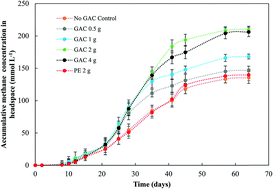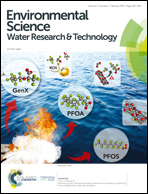Overcoming ammonia inhibition in anaerobic blackwater treatment with granular activated carbon: the role of electroactive microorganisms
Abstract
Methanogenesis and enrichment of microorganisms capable of interspecies electron and/or hydrogen exchange was investigated with addition of granular activated carbon (GAC) to batch anaerobic digesters treating vacuum collected blackwater with high ammonia concentration. The biochemical methane potential increased from 34% to 53%, while chemical oxygen demand removal efficiencies increased from 37% up to 56.7%. GAC did not influence the concentration of total ammonia but reduced its inhibition. The methanogenesis lag phase did not differ between groups. In 10 days, increases of up to 48% of acetate and up to 52% of propionate were observed in GAC cultures. After 45 days, propionate was depleted in all cultures, except the GAC 4 g culture. Acetate accumulated in control groups, reaching approximately 126 mg L−1 after 21 days. GAC promoted cell attachment and biofilm formation on its surface, while polyethylene did not. 16S rRNA gene sequencing revealed enhancement of conductive bacterial OTUs in the GAC group, including the Geobacteraceae family (4.0%) and the Clostridiales order (14%), while the versatile archaeal group Methanosarcina (∼63%) was preserved, and unclassified hydrogenotroph members of the Methanomicrobiales order increased by 14%. Results suggest that activated carbon improves methane production from blackwater degradation by enriching electroactive microorganisms tolerant to high ammonia concentrations.

- This article is part of the themed collection: Best Papers 2019 – Environmental Science: Water Research & Technology


 Please wait while we load your content...
Please wait while we load your content...